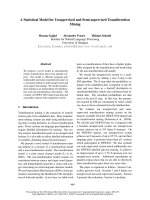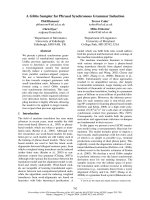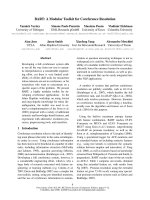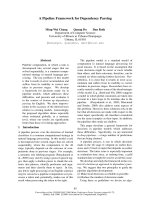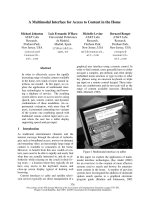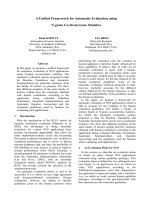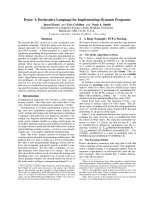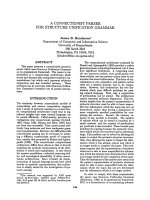Báo cáo khoa học: "A Graphical Tool for GermaNet Development" ppt
Bạn đang xem bản rút gọn của tài liệu. Xem và tải ngay bản đầy đủ của tài liệu tại đây (563.53 KB, 6 trang )
Proceedings of the ACL 2010 System Demonstrations, pages 19–24,
Uppsala, Sweden, 13 July 2010.
c
2010 Association for Computational Linguistics
GernEdiT: A Graphical Tool for GermaNet Development
Verena Henrich
University of Tübingen
Tübingen, Germany.
verena.henrich@uni-
tuebingen.de
Erhard Hinrichs
University of Tübingen
Tübingen, Germany.
erhard.hinrichs@uni-
tuebingen.de
Abstract
GernEdiT (short for: GermaNet Editing Tool)
offers a graphical interface for the lexicogra-
phers and developers of GermaNet to access
and modify the underlying GermaNet re-
source. GermaNet is a lexical-semantic word-
net that is modeled after the Princeton Word-
Net for English. The traditional lexicographic
development of GermaNet was error prone
and time-consuming, mainly due to a complex
underlying data format and no opportunity of
automatic consistency checks. GernEdiT re-
places the earlier development by a more user-
friendly tool, which facilitates automatic
checking of internal consistency and correct-
ness of the linguistic resource. This paper pre-
sents all these core functionalities of GernEdiT
along with details about its usage and usabil-
ity.
1 Introduction
The main purpose of the GermaNet Editing Tool
GernEdiT tool is to support lexicographers in
accessing, modifying, and extending the Ger-
maNet data (Kunze and Lemnitzer, 2002; Hen-
rich and Hinrichs, 2010) in an easy and adaptive
way and to aid in the navigation through the
GermaNet word class hierarchies, so as to find
the appropriate place in the hierarchy for new
synsets (short for: synonymy set) and lexical
units. GernEdiT replaces the traditional Ger-
maNet development based on lexicographer files
(Fellbaum, 1998) by a more user-friendly visual
tool that supports versioning and collaborative
annotation by several lexicographers working in
parallel.
Furthermore, GernEdiT facilitates internal
consistency of the GermaNet data such as appro-
priate linking of lexical units with synsets,
connectedness of the synset graph, and automatic
closure among relations and their inverse coun-
terparts.
All these functionalities along with the main
aspects of GernEdiT’s usage and usability are
presented in this paper.
2 The Structure of GermaNet
GermaNet is a lexical-semantic wordnet that is
modeled after the Princeton WordNet for English
(Fellbaum, 1998). It covers the three word cate-
gories of adjectives, nouns, and verbs and parti-
tions the lexical space into a set of concepts that
are interlinked by semantic relations. A semantic
concept is modeled by a synset. A synset is a set
of words (called lexical units) where all the
words are taken to have (almost) the same mean-
ing. Thus a synset is a set-representation of the
semantic relation of synonymy, which means
that it consists of a list of lexical units.
There are two types of semantic relations in
GermaNet: conceptual and lexical relations.
Conceptual relations hold between two semantic
concepts, i.e. synsets. They include relations
such as hyperonymy, part-whole relations, en-
tailment, or causation. GermaNet is hierarchi-
cally structured in terms of the hyperonymy rela-
tion. Lexical relations hold between two individ-
ual lexical units. Antonymy, a pair of opposites,
is an example of a lexical relation.
3 The GermaNet Editing Tool
The GermaNet Editing Tool GernEdiT provides
a graphical user interface, implemented as a Java
Swing application, which primarily allows main-
taining the GermaNet data in a user-friendly
way. The editor represents an interface to a rela-
tional database, where all GermaNet data is
stored from now on.
19
Figure 1. The main view of GernEdiT.
3.1 Motivation
The traditional lexicographic development of
GermaNet was error prone and time-consuming,
mainly due to a complex underlying data format
and no opportunity of automatic consistency
checks. This is exactly why GernEdiT was de-
veloped: It supports lexicographers who need to
access, modify, and extend GermaNet data by
providing these functions through simple button-
clicks, searches, and form editing. There are sev-
eral ways to search data and browse through the
GermaNet graph. These functionalities allow
lexicographers, among other things, to find the
appropriate place in the hierarchy for the inser-
tion of new synsets and lexical units. Last but not
least, GernEdiT facilitates internal consistency
and correctness of the linguistic resource and
supports versioning and collaborative annotation
of GermaNet by several lexicographers working
in parallel.
3.2 The Main User Interface
Figure 1 illustrates the main user panel of Gern-
EdiT. It shows a Search panel above, two panels
for Synsets and Lexical Units in the middle, and
four tabs below: a Conceptual Relations Editor, a
Graph with Hyperonyms and Hyponyms, a Lexi-
20
Figure 2: Filtered list of lexical units.
cal Relations Editor, and an Examples and
Frames tab.
In Figure 1, a search for synsets consisting of
lexical units with the word Nuss (German noun
for: nut) has been executed. Accordingly, the
Synsets panel displays the three resulting synsets
that match the search item. The Synset Id is the
unique database ID that unambiguously identi-
fies a synset, and which can also be used to
search for exactly that synset. Word Category
specifies whether a synset is an adjective (adj), a
noun (nomen), or a verb (verben), whereas Word
Class classifies the synsets into semantic fields.
The word class of the selected synset in Figure 1
is Nahrung (German noun for: food). The Para-
phrase column contains a description of a synset,
e.g., for the selected synset the paraphrase is: der
essbare Kern einer Nuss (German phrase for: the
edible kernel of a nut). The column All Orth
Forms simply lists all orthographical variants of
all its lexical units.
Which lexical units are listed in the Lexical
Units panel depends on the selected synset in the
Synsets panel. Here, Lex Unit Id and Synset Id
again reflect the corresponding unique database
IDs. Orth Form (short for: orthographic form)
represents the correct spelling of a word accord-
ing to the rules of the spelling reform Neue
Deutsche Rechtschreibung (Rat für deutsche
Rechtschreibung, 2006), a recently adopted
spelling reform. In our example, the main ortho-
graphic form is Nuss. Orth Var may contain an
alternative spelling that is admissible according
to the Neue Deutsche Rechtschreibung.
1
Old
Orth Form represents the main orthographic
form prior to the Neue Deutsche Recht-
schreibung. This means that Nuß was the correct
spelling instead of Nuss before the German spell-
ing reform. Old Orth Var contains any accepted
variant prior to the Neue Deutsche Recht-
schreibung. The Old Orth Var field is filled only
if it is no longer allowed in the new orthography.
The Boolean values Named Entity, Artificial,
and Style Marking express further properties of a
lexical unit, whether the lexical unit is a named
entity, an artificial concept node, or a stylistic
variant.
For both the lexical units and the synsets, there
are two buttons Use as From and Use as To,
which help to add new relations (see the explana-
tion of Figure 3 in section 3.6 below which ex-
plains the creation of new relations).
3.3 Search Functionalities
It is possible to search for words or synset data-
base IDs via the search panel (see Figure 1 at the
top). The check box Ignore Case offers the pos-
sibility of searching without distinguishing be-
tween upper and lower case.
1
An example of this kind is the German word Delfin (Ger-
man noun for: dolphin). Apart from the main form Delfin,
there is an orthographic variant Delphin.
21
Figure 3. Conceptual Relations Editor tab.
Via the file menu, lists of all synsets or lexical
units with their properties can be accessed. To
these lists, very detailed filters can be applied:
e.g., filtering the lexical units or synsets by parts
of their orthographical forms. Figure 2 shows a
list of lexical units to which a detailed filter has
been applied: verbs have been chosen (see the
chosen tab) whose orthographical forms start
with an a- (see starts with check box and corre-
sponding text field) and end with the suffix -ten
(see ends with check box and corresponding text
field). Only verbs that have a frame that contains
NN are chosen (see Frame contains check box
and corresponding text field). Furthermore, the
resulting filtered list is sorted in descending or-
der by their examples (see the little triangle in
the Examples header of the result table). The
number in the brackets behind the word category
in the tab title indicates the count of the filtered
lexical units (in this example 193 verbs pass the
filter).
3.4 Visualization of the Graph Hierarchy
There is the possibility to display a graph with all
hyperonyms and hyponyms of a selected synset.
This is shown in the bottom half of Figure 1 in
the tab Graph with Hyperonyms and Hyponyms.
The graph in Figure 1 visualizes a part of the hi-
erarchical structure of GermaNet centered
around the synset containing Nuss and displays
the hyperonyms and hyponyms of this synset up
to a certain parameterized depth (in this case
depth 2 has been chosen). The Hyperonym Depth
chooser allows unfolding the graph to the top up
to the preselected depth. As it is not possible to
visualize the whole GermaNet contents at once,
the graph can be seen as a window to GermaNet.
A click on any synset node within the graph,
navigates to that synset. This functionality sup-
ports lexicographers especially in finding the
appropriate place in the hierarchy for the inser-
tion of new synsets.
3.5 Modifications of Existing Items
If the lexicographers’ task is to modify existing
synsets or lexical units, this is done by selecting
a synset or lexical unit displayed in the Synsets
and the Lexical Units panels shown in Figure 1.
The properties of such selected items can be ed-
ited by a click in the corresponding table cell.
For example by clicking in the cell Orth Form
the spelling of a lexical unit can be corrected in
case of an earlier typo was made.
If lexicographers want to edit examples,
frames, conceptual, or lexical relations this is
done by choosing the appropriate tab indicated at
the bottom of Figure 1. By clicking one of these
tabs, the corresponding panel appears below
these tabs. In Figure 1 the panel for Graph with
Hyperonyms and Hyponyms is displayed.
It is possible to edit the examples and frames
associated with a lexical unit via the Examples
and Frames tab. Frames specify the syntactic
valence of a lexical unit. Each frame can have an
associated example that indicates a possible us-
age of the lexical unit for that particular frame.
The tab Examples and Frames is thus particu-
larly geared towards the editing of verb entries.
By clicking on the tab all examples and frames
of a lexical unit are listed and can then be modi-
fied by choosing the appropriate editing buttons.
For more information about these editing func-
tions see Henrich and Hinrichs (2010).
22
Figure 4. Synset Editor (left). Lexical Units Editor (right).
3.6 Editing of Relations
If lexicographers want to add new conceptual or
lexical relations to a synset or a lexical unit this
is done by clicking on the Conceptual Relations
Editor or the Lexical Relations Editor shown in
Figure 1.
Figure 3 shows the panel that appears if the
Conceptual Relations Editor has been chosen for
the synset containing Nuss. To create a new rela-
tion, the lexicographer needs to use the buttons
Use as From and Use as To shown in Figure 1.
This will insert the ID of the selected synsets
from the Synsets panel in the corresponding
From or To field in Figure 3. The button Delete
ConRel allows deletion of a conceptual relation,
if all consistency checks are passed.
The Lexical Relations Editor tab supports edit-
ing all lexical relations. It is not displayed sepa-
rately for reasons of space, but it is analogue to
the Conceptual Relations Editor tab for editing
conceptual relations.
3.7 Adding Synsets and Lexical Units
The buttons Add New Hyponym and Add New
LexUnit in the Synsets panel (see Figure 1) can
be used to insert a new synset or lexical unit at
the selected place in the GermaNet graph, and
the buttons Delete Synset and Delete LexUnit
remove the selected entry, respectively.
The Synset Editor in Figure 4 (on the left)
shows the window which appears after a click on
Add New Hyponym. When clicking on the button
Create Synset, the Lexical Unit Editor (shown in
Figure 4, right) pops up. This workflow forces
the parallel creation of a lexical unit while creat-
ing a synset.
3.8 Consistency Checks
GernEdiT facilitates internal consistency of the
GermaNet data. This is achieved by the
workflow-oriented design of the editor. It is not
possible to create a synset without creating a
lexical unit in parallel (as described in section
3.7). Furthermore, it is not possible to insert a
new synset without specifying the place in the
GermaNet hierarchy where the new synset
should be added. This is achieved by the button
Add New Hyponym (see Figure 1) which forces
the user to identify the appropriate hyperonym
for the new synset to be added. Furthermore, it is
not possible to insert a lexical unit without speci-
fying the corresponding synset. On deletion of a
synset, all corresponding data such as conceptual
relations, lexical units with their lexical relations,
frames, and examples, are deleted automatically.
Consistency checks also take effect for the ta-
ble cell editing in the Synsets and Lexical Units
panels of the main user interface (see Figure 1),
e.g., the main orthographic form of a lexical unit
may never be empty.
All buttons in GernEdiT are enabled only if
the corresponding functionalities meet the con-
sistency requirements, e.g., if a synset consists
only of one lexical unit, it is not possible to de-
lete that lexical unit and thus the button Delete
LexUnit is disabled. Also, if the deletion of a
synset or a relation would violate the complete
connectedness of the GermaNet graph, it is not
possible to delete that synset.
3.9 Further Functionalities
There are further functionalities available
through the file menu. Besides retrieving the up-
to-date statistics of GermaNet, an editing history
makes it possible to list all modifications on the
GermaNet data, with the information about who
made the change and how the modified item
looked before.
GernEdiT supports various export functionali-
ties. For example, it is possible to export all
GermaNet contents into XML files, which are
used as an exchange format of GermaNet, or to
23
export a list of all verbs with their corresponding
frames and examples.
4 Tool Evaluation
In order to assess the usefulness of GernEdiT, we
conducted in depth interviews with the Germa-
Net lexicographers and with the senior researcher
who oversees all lexicographic development. At
the time of the interview all of these researchers
had worked with the tool for about eight months.
The present section summarizes the feedback
about GernEdiT that was obtained in this way.
The initial learning curve for getting familiar
with GernEdiT is considerably lower compared
to the learning curve required for the traditional
development based on lexicographer files.
Moreover, the GermaNet development with
GernEdiT is both more efficient and accurate
compared to the traditional development along
the following dimensions:
1. The menu-driven and graphics-based
navigation through the GermaNet graph is
much easier compared to finding the cor-
rect entry point in the purely text-based
format of lexicographer files.
2. Lexicographers no longer need to learn the
complex specification syntax of the lexi-
cographer files. Thereby, syntax errors in
the specification language – a frequent
source of errors prior to development with
GernEdiT – are entirely eliminated.
3. GernEdiT facilitates automatic checking
of internal consistency and correctness of
the GermaNet data such as appropriate
linking of lexical units with synsets, con-
nectedness of the synset graph, and auto-
matic closure among relations and their
inverse counterparts.
4. It is now even possible to perform further
queries, which were not possible before,
e.g., listing all hyponyms of a synset.
5. Especially for the senior researcher who is
responsible for coordinating the GermaNet
lexicographers, it is now much easier to
trace back changes and to verify who was
responsible for them.
6. The collaborative annotation by several
lexicographers working in parallel is now
easily possible and does not cause any
management overhead as before.
In sum, the lexicographers of GermaNet gave
very positive feedback about the use of Gern-
EdiT and also made smaller suggestions for im-
proving its user-friendliness further. This under-
scores the utility of GernEdiT from a practical
point of view.
5 Conclusion and Future Work
In this paper we have described the functionality
of GernEdiT. The extremely positive feedback of
the GermaNet lexicographers underscores the
practical benefits gained by using the GernEdiT
tool in practice.
At the moment, GernEdiT is customized for
maintaining the GermaNet data. In future work,
we plan to adapt the tool so that it can be used
with wordnets for other languages as well. This
would mean that the wordnet data for a given
language would have to be stored in a relational
database and that the tool itself can handle the
language specific data structures of the wordnet
in question.
Acknowledgements
We would like to thank all GermaNet lexicogra-
phers for their willingness to experiment with
GernEdiT and to be interviewed about their ex-
periences with the tool.
Special thanks go to Reinhild Barkey for her
valuable input on both the features and user-
friendliness of GernEdiT and to Alexander Kis-
lev for his contributions to the underlying data-
base format.
References
Claudia Kunze and Lothar Lemnitzer. 2002. Ger-
maNet – representation, visualization, appli-
cation. Proceedings of LREC 2002, Main Confer-
ence, Vol V. pp. 1485-1491, 2002.
Christiane Fellbaum (ed.). 1998. WordNet – An
Electronic Lexical Database. Cambridge, MA:
MIT Press.
Verena Henrich and Erhard Hinrichs. 2010. GernEdiT
– The GermaNet Editing Tool. Proceedings of
LREC 2010, Main Conference, Valletta, Malta.
Rat für deutsche Rechtschreibung (eds.) (2006).
Deutsche Rechtschreibung – Regeln und
Wörterverzeichnis: Amtliche Regelung. Gunter
Narr Verlag Tübingen.
24

